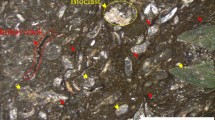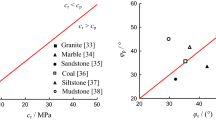Abstract
The damage constitutive model and the evolution characteristics of the cracked rock, considering seepage pressure, are critical to the stability of the cracked rock engineering. Based on the Rice Theory of Thermodynamics and the friction-bending crack model, we proposed the damage evolution model for the cracked rock in the compressive-shear state, considering the seepage pressure, the initial damage of the cracked rock, and the accumulated damage caused by crack evolution. According to the influences of the normal deformation and the branched crack (caused by the seepage pressure and the normal stress) on the opening of the crack, we established an evolution equation for the seepage tensors with the accumulation of the crack damage. In addition, based on the visual development platform, VB 6.5, we developed the software, WFRD2D, to comprehensively calculate the nonlinear damage deformation, the strength and the seepage indexes of the cracked rock, subjected to seepage pressure. Then, we obtained the pre-peak stress–strain curve of the cracked iherzolite rock using WFRD2D. The results show that the rock strength decreased by 48%, whereas the lateral strain increased by 240%, considering the seepage pressure of 3 MPa. These phenomena indicate that seepage pressure damages the cracked rock, then, further decreases the rock strength and increases the lateral strain. Thus, the seepage pressure significantly affects the mechanical properties of the cracked rock.







Similar content being viewed by others
References
Cao P, Liu TY, Pu CZ, Lin H (2015) Crack propagation and coalescence of brittle rock-like specimens with pre-existing cracks in compression. Eng Geol 187:113–121
Cao RH, Cao P, Lin H, Pu CZ, Ou K (2016) Mechanical behavior of brittle rock-like specimens with pre-existing fissures under uniaxial loading: experimental studies and particle mechanics approach. Rock Mech Rock Eng 49(3):763–783
Duriez J, Scholtès L, Donzé FV (2016) Micromechanics of wing crack propagation for different flaw properties. Eng Fract Mech 153:378–398
Fan X, Kulatilake PHSW, Chen X (2015) Mechanical behavior of rock-like jointed blocks with multi-non-persistent joints under uniaxial loading: a particle mechanics approach. Eng Geol 190:17–32
Gratchev I, Kim DH, Yeung CK (2016) Strength of rock-like specimens with pre-existing cracks of different length and width. Rock Mech Rock Eng 49(11):4491–4496
Haeri H, Shahriar K, Marji MF, Moarefvand P (2014) Experimental and numerical study of crack propagation and coalescence in pre-cracked rock-like disks. Int J Rock Mech Min Sci 67:20–28
Kemeny JM, Coo NGW (1987) Crack models for the failure of rocks in compression. In: Desai CS, Krempl E, Kiousis PD, Kundu T (eds) Constitutive laws for engineering materials: theory and applications, vol 2. Elsevier, New York, pp 879–887
Li SP, Li YS, Wu ZY (1995) The permeability-strain equations relating to complete stress-strain path of the roek. Chinese Journal of Geotechnical Engineering 17(2):13–19
Li XF, Liu GL, Lee KY (2009) Effects of T-stresses on fracture initiation for a closed crack in compression with frictional crack faces. Int J Fract 160(1):19–30
Liu J, Wang J (2018) Stress evolution of rock-like specimens containing a single fracture under uniaxial loading: a numerical study based on particle flow code. Geotech Geol Eng 26(1):267–280
Lu C, Guo JC, Liu LM (2016) A new calculation model for the stress field of hydraulic fracture propagation at the formation interface. Environ Earth Sci 75(16):1178
Miao S, Wang H, Cai M, Song Y, Ma J (2018) Damage constitutive model and variables of cracked rock in a hydro-chemical environment. Arab J Geosci 11(2):19
Nemat NS, Horii H (1982) Compression-induced nonplanar crack extension with application to splitting, exfoliation and rock burst. J Geophys Res 87(B8):6805–6821
Ren F, Ma G, Wang Y, Fan L (2016) Pipe network model for unconfined seepage analysis in fractured rock masses. Int J Rock Mech Min Sci 88:183–196
Rice JR (1971) Inelastic constitutive relations for solids: an internal-variable theory and its application to metal plasticity. J Mech Phys Solids 19(6):433–455
Soni AK, Manwatkar B (2015) Seepage modeling for a large open pit coal mine in India. Geotech Geol Eng 33(4):1–11
Zhang W, Dai B, Liu Z, Zhou C (2017) Modeling free-surface seepage flow in complicated fractured rock mass using a coupled RPIM-FEM method. Transp Porous Media 117(3):443–463
Zhao Y, Tang J, Chen Y, Zhang L, Wang W, Liao J (2016a) Hydromechanical coupling tests for mechanical and permeability characteristics of fractured limestone in complete stress–strain process. Environ Earth Sci 76:24
Zhao Y, Zhang L, Wang W, Pu C, Wan W, Tang J (2016b) Cracking and stress–strain behavior of rock-like material containing two flaws under uniaxial compression. Rock Mech Rock Eng 49(7):2665–2687
Zhao Y, Zhang L, Wang W, Tang Z, Lin H, Wan W (2017a) Transient pulse test and morphological analysis of single rock fractures. Int J Rock Mech Min Sci 91:139–154
Zhao YL, Wang YX, Wang WJ, Wan W, Tang JZ (2017b) Modeling of non-linear rheological behavior of hard rock using triaxial rheological experiment. Int J Rock Mech Min Sci 93:66–75
Zhao YL, Zhang LY, Wang WJ, Wan W, Ma WH (2018) Separation of elastoviscoplastic strains of rock and a nonlinear creep model. Int J Geomech. https://doi.org/10.1061/(ASCE)GM.1943-5622.0001033
Acknowledgements
This research is supported by the National Natural Science Foundation of China (Nos. 51774131, 51274097, and 51434006), the CRSRI Open Research Program (CKWV2017508/KY), and the Open Projects of State Key Laboratory of Coal Resources and Safe Mining, CUMT (No. SKLCRSM16KF12).
Author information
Authors and Affiliations
Corresponding author
Rights and permissions
About this article
Cite this article
Zhao, Y., Tang, L., Liu, Q. et al. The Micro Damage Model of the Cracked Rock Considering Seepage Pressure. Geotech Geol Eng 37, 965–974 (2019). https://doi.org/10.1007/s10706-018-0663-z
Received:
Accepted:
Published:
Issue Date:
DOI: https://doi.org/10.1007/s10706-018-0663-z




